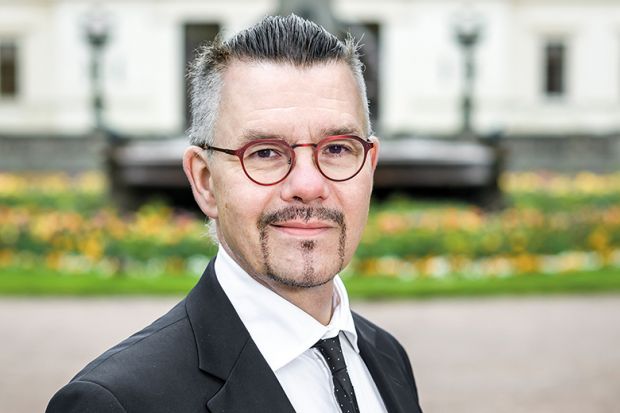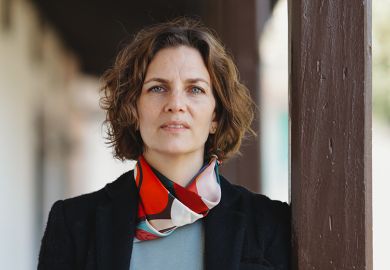Browse the full results of the World University Rankings 2024
Should a university appoint a leader from within its walls or search further afield for someone with an outsider’s perspective?
The question has recently returned to the fore following the high-profile appointments to top posts at leading UK and US universities. The University of Oxford, for instance, looked within its own walls for the first time since 1997 when it appointed its latest head, Irene Tracey; by contrast, the University of Cambridge’s new vice-chancellor, Deborah Prentice, worked at Princeton University for 34 years.
Erik Renström, who became head of Lund University in Sweden in January 2021, 26 years after first joining the institution as a clinical assistant at the university hospital, falls into the first category of insiders who have recently taken the helm.
Campus resource: How to work with industry in mutually beneficial ways
But Renström, a professor of experimental endocrinology who took the position following a stint as dean of the faculty of medicine from 2018, required some time to warm to the idea. He admits that he was initially against becoming a dean – let alone vice-chancellor – at a university where he had spent two decades as a researcher.
“You have friends with whom you have collaborated over a number of years, and you will have to make people disappointed,” he recalls thinking ahead of his first administrative role.
On accepting the position, however, he was pleasantly surprised: “The things I had feared did not materialise. I found that people are…prepared to accept quite harsh messages if they understand why.”
When the vice-chancellor’s job came up, he was less concerned about being an insider. Timing was a more important factor.
“I felt that I had barely started as dean of medicine, but I decided that if I’m ever going to become the vice-chancellor, now is the time. I don’t want to do it in six years or later,” he says.
“In my mind, that would be quite late. I’m not sure it’s a great idea to be a vice-chancellor when you’re 70. I think you should be reasonably close to when you have acted as a researcher yourself, and as a teacher. I find it very important to maintain that identity, and I am one of the academic staff now who has taken on this role…At the same time, you have to prepare yourself for being alone at times.”
More than two and a half years into the job, he stands by his decision: “My schedule is punishing. You have to have the stamina.”
Like many universities in Sweden, Lund is a hotbed for innovation. Bluetooth, artificial kidneys and oat milk are among the discoveries made by researchers at the institution. Each of these was either created in collaboration with industry or resulted in the foundation of a new company.
But Renström says that what stands out at Lund is the relationship between industry and student life, and the multidisciplinary nature of business partnerships.
“Yes, it’s about heat exchange,” he says, referencing the university’s longstanding partnership with Alfa Laval, which produces specialised products and solutions for heavy industry. “But it’s also about having a society, a cultural scene that’s inspiring and interesting. The students definitely influence the vibe of the city of Lund immensely, and also beyond in the entire region. So we also see the value of collaborating [with industry] in the cultural sector and the creative sector.”
Lund has a non-profit student organisation called the Academic Society, with “a purpose of gathering and broadening the cultural aspect of the student life”. While it is managed entirely by students, with its ongoing activities financed through membership fees, major renovations depend on donations from alumni or businesses, primarily in the local area.
“The society dates back to 1830 and has no real equivalents nationally. Its importance for student life in Lund cannot be overestimated,” Renström says.
Another large part of the student experience involves getting a taste of the work culture inside the industry giants headquartered just miles away.
Renström’s own first encounter with industry was as a PhD student, when he worked at the pharmaceutical company Novo Nordisk. He admits that he “didn’t feel too enthusiastic” because he considered himself an academic at heart. But he says it was a “formative experience” that became useful when he started working in innovation later in his academic career.
“I didn’t want to design experiments according to what is required for this to become a successful drug on the market,” he recalls. “I wanted to do the things that I felt were interesting. As an academic…you move from one question mark to another. You are sometimes not very interested in having a final result.”
But with the benefit of hindsight, Renström now cautions against seeing research done with industry as inferior to blue-sky research.
“When we analyse research output during the last decade, we can see that a collaboration with an external partner increases the number of citations…So there’s no competition between involvement with external stakeholders and pursuing high-quality academic research,” he says.
In Renström’s experience, the most challenging aspect of university-industry collaboration is not the researchers – “they have no problems with collaborating with each other” – it’s the legal contracts and agreements around aspects such as publication policies.
At Lund, it is “an absolute must” that any industry-collaborated research is integrated into educational programmes as quickly as possible, he says. “We don’t want to have an embargo of three or five years for that.”
It is also important to think through carefully what topics you can include in collaborative research – and what to leave out, he says.
“You have to identify the borders, which you usually would not pay too much attention to if you were working purely on academic research. Because there, of course, you let everything cross-fertilise with everything else.”
Despite the challenges, he says, he has “always been a great champion” for external engagement. “I really love academic research and going deep in your own subject”, he says. “I think you can combine both.”
Renström says that “almost all of the big companies” in Lund and surrounding the city “come from the university or have collaborated with the university quite intensely for the last couple of hundred years”, with examples including Tetra Pak and Gambro, among others.
“That builds on the tradition that we have established a relationship with the society at large,” he says. “It’s both us – how we cooperate with the industry…and civil society. But also, society at large expects something useful to emanate from the university.”
But the institution’s industry collaborations are set to become increasingly global. Lund’s industry partners are particularly interested in benefiting from the university’s international networks – given the potential reach of millions of students worldwide.
“This is a new dimension they haven’t thought about before,” Renström says.
If Ikea is interested in expanding its reach in Australia, for example, Lund can set up a conversation with one of its Australian university collaborators for a potential partnership on a graduate project, he explains. His institution can also act as a go-between with companies, sharing its knowledge of a particular area and explaining the relevant academic strengths, he says.
“The advantages are, among other things, that the companies get a better picture of the whole of the tasks that rest on a university – not least the extensive international collaboration that links universities all over the world, and that we are more than a supplier of labour.”
Closer to home, Lund is also looking into how it can be part of a European “innovation valley” – a concept announced in the European Commission’s New European Innovation Agenda last year. The agenda suggests bringing together “less and more innovative regions with a view to addressing the most burning challenges facing the EU, namely reducing the reliance on fossil fuels, increasing global food security, mastering the digital transformation (including cybersecurity), improving healthcare and achieving circularity”.
Renström says the Skåne region of Sweden – where Lund is situated – is working on an application and plans to “connect partners from other regions internationally as soon as possible”. He cites an innovation valley in the Baltic region, “stretching from Sweden down to Hamburg” in Germany, as a possibility, involving higher education institutions, companies and cities.
“We envision ourselves building on the unique selling points that exist in our part of the world,” he says. “These include the large facilities for synchrotron and neutron science, excellence in deep tech and life science, but also the cultural and creative industries. They are all more connected than first meets the eye.”
ellie.bothwell@timeshighereducation.com
This is part of our “Talking leadership” series with the people running the world’s top universities about how they solve common strategic issues and implement change. Follow the series here.
Register to continue
Why register?
- Registration is free and only takes a moment
- Once registered, you can read 3 articles a month
- Sign up for our newsletter
Subscribe
Or subscribe for unlimited access to:
- Unlimited access to news, views, insights & reviews
- Digital editions
- Digital access to THE’s university and college rankings analysis
Already registered or a current subscriber? Login








